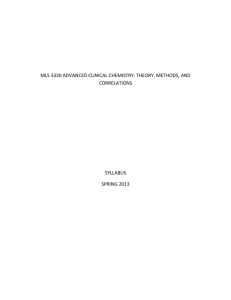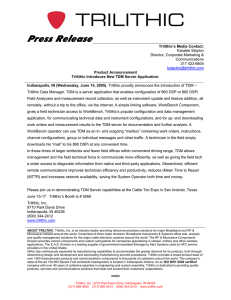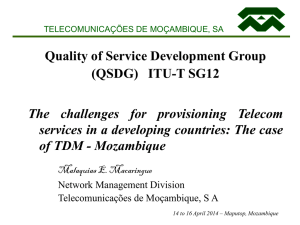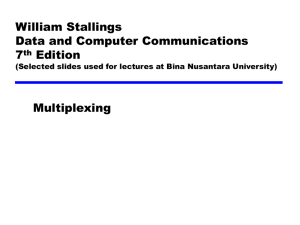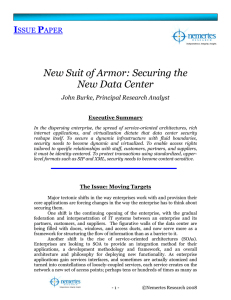16 08 Business Value Analysis Cisco Unified Communications Manager
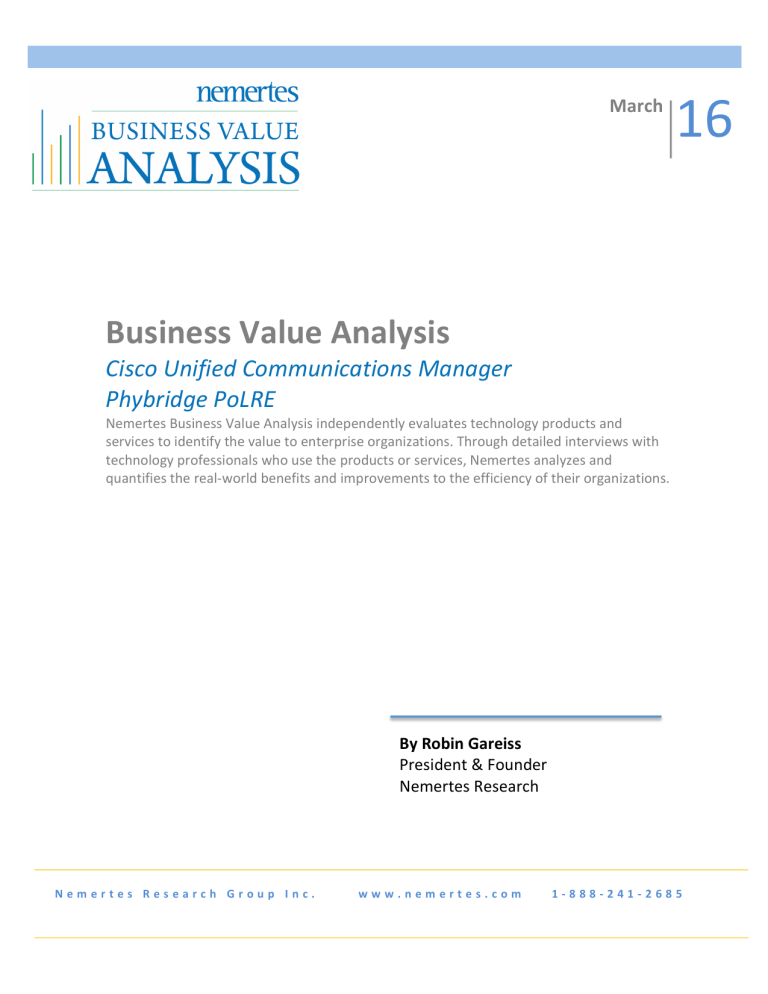
Fall
08
March
16
Business Value Analysis
Cisco Unified Communications Manager
Phybridge PoLRE
Nemertes Business Value Analysis independently evaluates technology products and services to identify the value to enterprise organizations. Through detailed interviews with technology professionals who use the products or services, Nemertes analyzes and quantifies the real-world benefits and improvements to the efficiency of their organizations.
By Robin Gareiss
President & Founder
Nemertes Research
N e m e r t e s R e s e a r c h G r o u p I n c . w w w . n e m e r t e s . c o m 1 - 8 8 8 - 2 4 1 - 2 6 8 5
B usiness V alue A nalysis
TABLE OF CONTENTS
Executive Summary ................................................................................................................................... 3
Technology Adoption and Challenges ................................................................................................. 4
IP Telephony Business Value Analysis ................................................................................................ 6
Cisco Unified CM, Phybridge PoLRE Business Value Analysis ..................................................... 8
Profile of Research Participants ................................................................................................................................ 8
Summary of Research Findings ................................................................................................................................. 8
MTTR Reduction ..................................................................................................................................................... 8
Equipment Maintenance Reduction ............................................................................................................... 9
MAC Cost Reduction ............................................................................................................................................ 10
FTE Reductions ..................................................................................................................................................... 10
Time to Dollar Value ........................................................................................................................................... 10
Case Studies ................................................................................................................................................ 12
Conclusion ................................................................................................................................................... 23
Methodology ............................................................................................................................................... 24
©Nemertes Research 2016 !
www.nemertes.com
!
888-241-2685 !
DN5000 2
B usiness V alue A nalysis
Executive Summary
Though IP telephony has been available commercially since the mid ‘90s, it remains an emerging technology for many organizations. Only about 28% of companies have moved all endpoints (handsets, softphones, audio bridges) to IP, according to Nemertes’ research data. The rest of organizations are either in the process of migrating fully to IP, stuck in a hybrid rollout requiring them to manage typically multiple TDM and IP providers, or firmly planted in TDM.
Inhibitors toward moving to a full IP deployment include lack of business case or budget, no user demand, cost of network upgrades, and physical building issues. As organizations run disjointed telecommunications infrastructure, their costs are higher and efficiencies lower than those who have moved or are moving to a full IP environment, according to the research data.
Through interviews with 10 companies, Nemertes has identified and measured the following benefits of moving to an all-IP environment:
•
22% reduction in Full-Time Equivalents (FTEs) required to manage the systems
•
34% reduction in the cost of equipment maintenance
•
31% reduction in the cost of Moves, Adds, and Changes (MACs)
•
71% reduction in Mean Time to Repair (MTTR)
Though full IP may be the goal, some IT leaders believe it never can be reality. That’s because their buildings or budgets may not accommodate the migration. In those cases, companies have found success using Power over Long-Range Ethernet solutions (PoLRE).
Among the 10 companies interviewed, three are using or evaluating switches from
Phybridge to bridge the gap between TDM and IP, and two are evaluating the technology
(layer 2 switches that deliver Power Over Ethernet over a single pair of wires with four times the reach of traditional switches, transforming TDM voice infrastructure into an IP path with power). Among the anecdotal benefits identified:
•
Reduction in cabling and hardware costs to upgrade LAN infrastructure
•
Reduction in labor for those infrastructure upgrades
•
Less disruption to the physical building normally required for full LAN upgrades
This report reviews the issues and benefits associated with moving to an all-IP environment, based on interviews with IT professionals who have moved to all IP or are in the process of doing so.
©Nemertes Research 2016 !
www.nemertes.com
!
888-241-2685 !
DN5000 3
B usiness V alue A nalysis
Technology Adoption and Challenges
Though IP telephony has been demonstrating benefits for 20+ years, most companies—particularly large enterprises—continue to operate a mixed environment of both legacy TDM and IP. Among all companies, all sizes, that have begun using some
IP telephony, 45% operate a mix of IP and TDM, while 31% have on-premises
Deployment Among Those Using IP
Cloud
24%
All IP On
Premises
31% deployments that are fully IP. (Please see Figure 1.)
Those with larger, more distributed, and more complex environments tend to stay with a mixed telephony deployment for longer. Among large companies with more than 5,000 employees, 54% are running a mix of IP and TDM. Among
Mix of IP, TDM
45% that demographic, the estimated timeframe for full IP deployment for
24.4% is not expected to happen until
2017 to 2025. “We may or may not
Figure 1: Deployment Differences, All Size Companies ever get there,” says the IT director for a transportation company.
During interviews with hundreds of IT professionals over several different research projects, Nemertes has characterized the following challenges of full IP deployment:
•
Awareness – IT leaders sometimes are not aware of the benefits of moving all communications to the same IP platform. Not only do operational costs drop, but also feature-functionality improves when all employees are using integrated communications capabilities. Additionally, some are not aware of the value of PoLRE systems in enabling IP in prohibitive buildings (i.e., old buildings with concrete walls, buildings that require costly preparation to run new cabling, etc.) or where budget to upgrade the LAN and/or associated infrastructure does not exist—yet the need for IP telephony does.
•
Budget – Several IT leaders could not justify the budget required to “fix what isn’t broken.” TDM is working and continues to be supported, so no need to rock the boat. Only when the equipment becomes end-of-life and the company can no longer find support or spare parts does budget become available. However, those who do move to IP find immediate benefits in employee productivity by streamlining feature sets, centralizing management, and reducing maintenance and operational costs.
©Nemertes Research 2016 !
www.nemertes.com
!
888-241-2685 !
DN5000 4
B usiness V alue A nalysis
•
Ability to change infrastructure – In some cases, organizations cannot upgrade their infrastructure. For example, installers may not be able to penetrate the stone walls of old buildings on university or corporate campuses to upgrade cabling. Or in other cases, such as when installations must require overtime pay, it may be cost-prohibitive to perform the upgrades.
•
No user demand – Some organizations require documented user demand prior to spending money to add a new technology. Employees often do not see the value of moving to an all-IP environment from a functional TDM world, so IT cannot get budget to upgrade.
Though there are many reasons to move to an all IP environment, most organizations say the catalyst for that change was end of life for existing equipment. Other reasons cited include consolidation of disparate equipment; ease of maintenance and troubleshooting; vendor investment in the technology; and the ability to offer integrated feature sets.
Sometimes, the move simply comes down to a common sense financial decision, as was the case for one university, which was running a hybrid environment of Cisco IP and aging Rolm TDM PBXs: “We had an old Rolm system and asked our provider to estimate how much it would cost to move it. It was going to be $4 million to move the node to a new system, pull new cable, and do the new punch downs, with downtime of two weeks,” the lead telecom engineer says. Those figures led the university to solve the problem by moving its existing Cisco Unified Communications Managers to a new data center. “There was no outage, and it took us 30 minutes,” he says.
©Nemertes Research 2016 !
www.nemertes.com
!
888-241-2685 !
DN5000 5
B usiness V alue A nalysis
IP Telephony Business Value Analysis
Those who move to an all-IP environment find compelling cost savings in all metrics. In addition to the study Nemertes conducted specifically for this report, we also pulled data from additional research—namely, the Nemertes’ 2015-16 UC Total Cost of
Ownership study, now in its 11 th year. For that research, Nemertes gathers real-world cost data on companies using a variety of architectures.
Specifically, we gather information on capital, implementation, and operational costs using the following metrics and calculations:
•
Capital cost per endpoint : Includes PBX, endpoint devices and licenses, servers, other hardware. In some cases, bundled licenses include certain UC apps o = Capital costs / number of endpoints (handsets, softphones, etc.)
•
Implementation cost per endpoint : Includes staff time and third-party consultants and integrators o = ((Staff time * loaded hourly rate)+third-party costs)/ number of endpoints
•
Operational cost per endpoint : Includes staff time, equipment maintenance, third-party managed services, training and certification o = ((Number of FTEs * average annual loaded salary) + equipment maintenance + managed services + training/certification) / number of endpoints
We then segment this data by the type of deployment cited—all IP on premises, a mixture of TDM and IP, and cloud (Please see Figure 1.) Overall, organizations save 8% on their total costs for IP telephony when they move to all IP, according to the data.
This includes capital, implementation, and operational costs for all companies, all sizes, and all vendors. Figure 2 shows the total median cost per end unit at $734.68 for those
!$750.00!!
Total$Costs$Per$End$Unit$
!$734.68!!
still running a mixed environment, compared to $676.64 for those running all IP. (Please see Figure
2.) Segmented by size, the total
!$700.00!!
!$650.00!!
!$600.00!!
Mix$of$TDM,$IP$
!$676.64!!
All$IP$ cost savings is 9% for rollouts with more than 1,000 endpoints, but more importantly, the ongoing operational cost drops by 21%.
Extrapolated out by thousands of locations (as well as even one year, if not multiple), the cost savings
Figure 2: Median Cost Per End Unit, All Costs, All Sized Rollouts
©Nemertes Research 2016 !
www.nemertes.com
!
888-241-2685 !
DN5000 6
B usiness V alue A nalysis becomes very compelling.
Drilling down further into the components of the costs, it’s clear that across each metric—capital, implementation, and operational—organizations save money in an all
IP environment. Though many organizations reduce staff when going all-IP, the most significant cost savings comes from equipment maintenance (48%) and training (26% reduction), according to the data from the 2015-16 study. Though the actual number of
FTEs drops by 42% on average, the salaries tend to be higher for those managing IP vs. those managing TDM. As a result, the total compensation costs for the IT staff are the same or slightly lower in the research.
©Nemertes Research 2016 !
www.nemertes.com
!
888-241-2685 !
DN5000 7
B usiness V alue A nalysis
Cisco Unified CM, Phybridge PoLRE Business Value Analysis
Though many companies have started their journeys with IP telephony, relatively few have completed their deployments. Inhibitors include cost and staff constraints, legacy networks that cannot support IP telephony. Phybridge partners with Cisco to facilitate the move to IP without the need for infrastructure upgrades. For this project, we interviewed 10 companies, using a consistent set of questions, to determine the benefits in replacing TDM with IP.
Profile of Research Participants
Among the research participants, their deployments of IP telephony started between
2002 and 2015. We interviewed a mixture of companies from a variety of industries and sizes. The number of employees within the organizations ranges from 1,000 to
110,000.
All of the participants use Cisco for IP telephony and three use Phybridge (two others are evaluating the technology). Between 5% and 100% of their endpoints are on IP telephony, with an average of 59% of the total endpoints on IP telephony. Those who already are not running all IP have plans to do so within the next one to five years.
Summary of Research Findings
In the 10 interviews conducted, each company discovered benefits regarding reduction in time and/or costs, though the specific source of the benefits varied by company.
They centered around reductions in Mean Time to Repair (MTTR); equipment maintenance; Moves, Adds, and Changes (MACs); and Full-Time Equivalents (FTEs) required to manage the system. (Please see Figure 4.)
Those who used Phybridge saw savings in the cost to upgrade the LAN infrastructure—each for different reasons detailed in the case studies—ranging from
80% to 300%.
MTTR Reduction
Though several of the participants had not specifically measured the changes in their
MTTR, nearly all said they noticed an improvement moving from TDM to full IP. Among those that had measured, they found MTTR dropped by an average of 71%. In an all-
TDM or hybrid TDM/IP environment, they spent an average of 20.8 hours identifying a problem existed, determining the root cause, and finally resolving the problem. By far, the majority of the time was spent repairing the problem. The reasons for the delay?
Tracking down parts and/or waiting for off-site technicians to arrive to resolve the problem. In hybrid environments, they had to analyze data from both the TDM and IP systems to isolate the origin of the problem and determine the root cause. When they eliminated TDM entirely or from specific regions, they were able to reduce that time.
©Nemertes Research 2016 !
www.nemertes.com
!
888-241-2685 !
DN5000 8
B usiness V alue A nalysis
Once they moved into an all IP environment, the average number of hours for MTTR was 4.65 hours—much more reasonable. Given it’s newer technology with parts and expertise readily available, the reduction in troubleshooting time makes sense.
Key Findings: Savings With Full IP Deployment
MTTR reduction 71%
Equipment maintenance reduction 34%
MAC cost reduction 31%
FTE reduction 22%
Figure 3: Average Savings with Full IP Deployment
Equipment Maintenance Reduction
Another area of savings is equipment maintenance—though not for all of the research participants. On average, the savings was 34%, driven primarily by eliminating costly service agreements for aging equipment that required significant time and attention to keep running or to track down parts. With IP telephony, more players are in the market for equipment maintenance, so it’s more competitive. As a result, they are able to negotiate more affordable maintenance contracts.
Some, however, said they were not going to save any money on maintenance because their TDM equipment was so old, they could not find anyone to maintain all or part of the equipment, or their companies no longer budgeted for maintenance. So by upgrading the technology to IP, they were adding a new cost or spending the same as they were spending for limited locations that were still covered under maintenance.
©Nemertes Research 2016 !
www.nemertes.com
!
888-241-2685 !
DN5000 9
B usiness V alue A nalysis
MAC Cost Reduction
MACs, along with toll-charge reductions, were one of the early benefits companies moving to IP used to justify the costs. At the time, TDM MACs were commonly $350 to
$400 each. Now, most of the research participants said they spend $50 to $150 per
MAC, but the cost still drops by an average of 31% when moving to IP. In part, this is because it’s faster to do an IP MAC (15 minutes vs. 45 minutes), but more frequently, it’s because employees can simply pick up their own phones and move them when they switch offices. Only when a software or administrative change is required does IT even get involved.
Additionally, many companies were paying third parties to do TDM MACs because they were more cumbersome with the punch-downs that were required. Even in a hybrid
TDM/IP world, they still needed their service providers to handle those changes. But those who have moved fully to IP handle all MACs internally and spend less money doing so.
FTE Reductions
On average, research participants are saving 22% in the FTEs required to manage IP systems vs. TDM or hybrid TDM. When isolating those who have gone to at least 90%
IP, that percentage increases to 38%, indicating the movement to full IP generates more efficiencies with the IT staff.
Eight of the 10 companies who participated in the research reported some reduction in the FTEs, ranging from 13% to
44%. They reduced staff
IT#staff#members# managing#(FTE)
Hours#per# year
Average# hours#saved
Value#of#time# saved from an average of 10.5 FTEs with
TDM to nine with
IP, overall.
Time to Dollar
0.5
1
2
3
4
5
$$$$$$$$$$$$$$$1,040$ $$$$$$$$$$$$$$$229$ $$$$$$$$$$$$$$$$10,214$
$$$$$$$$$$$$$$$2,080$ $$$$$$$$$$$$$$$458$
$$$$$$$$$$$$$$$4,160$ $$$$$$$$$$$$$$$915$
$$$$$$$$$$$$$$$6,240$ $$$$$$$$$$$$1,373$
$$$$$$$$$$$$$$$8,320$ $$$$$$$$$$$$1,830$
$$$$$$$$$$$$$10,400$ $$$$$$$$$$$$2,288$
$$$$$$$$$$$$$$$$ 20,428
$$$$$$$$$$$$$$$$
$$$$$$$$$$$$$$$$
$$$$$$$$$$$$$$$$
$$$$$$$$$$$$$$
40,857
61,285
81,714
102,142
Value
Time generally translates into dollars. In cases where companies actually reduce staff, or even
Time$to$Dollars:$22%$Reduction$in$Time
10
25
50
100
$$$$$$$$$$$$$20,800$ $$$$$$$$$$$$4,576$
$$$$$$$$$$$$$52,000$ $$$$$$$$$$11,440$
$$$$$$$$$$$104,000$ $$$$$$$$$$22,880$
$$$$$$$$$$$208,000$ $$$$$$$$$$45,760$
Calculations+assume+2080+hours+par+year+and+average+salary+of+$71K;+30%+loading+factor
Figure 4: Time to Dollars
$$$$$$$$$$$$$$ 204,284
$$$$$$$$$$$$$$ 510,710
$$$$$$$$$$ 1,021,420
$$$$$$$$$$ 2,042,841
©Nemertes Research 2016 !
www.nemertes.com
!
888-241-2685 !
DN5000 10
B usiness V alue A nalysis reassign people to new departments (and corresponding budgets), the hard-dollar cost to manage the system drops—in some cases substantially.
Figure 5 shows the actual annual cost saved, using the documented average of 22% time reduction among these research participants when shifting to full IP. The figures are based on an average annual salary of $71,428 and 30% loading factor resulting from this research project.
Of course, in many cases, organizations maintain the same staff size, but shift people to new responsibilities or replace them with people who have new skillsets. If the companies move people to new roles, they indirectly save money by avoiding the cost of hiring new people to handle those new responsibilities. More broadly, efficiencies gained by enabling a full IP deployment free up positions to help IT focus on corporate innovation or digital transformation projects—helping business leaders identify how technology can improve the business.
Meanwhile, employees become more efficient and productive by using consistent feature sets (abbreviated dialing, consistent dial logs, mobile enablement, integration with UC and collaboration, etc.).
©Nemertes Research 2016 !
www.nemertes.com
!
888-241-2685 !
DN5000 11
B usiness V alue A nalysis
Case Studies
As stated, Nemertes interviewed 10 companies to determine the business value they discovered moving to or toward a Cisco all-IP environment. In nearly all cases, the companies saw measurable savings in the number of FTEs needed to manage the technology. In others, they saw savings in equipment maintenance, MACs, or WAN costs.
Some discovered challenges when they tried to upgrade their LAN infrastructure to enable IP either throughout most of the organization or at select locations. Those organizations leveraged Phybridge to enable IP by transforming the existing two-wire infrastructure into an IP path with power.
The next several pages provide details on each of the companies.
©Nemertes Research 2016 !
www.nemertes.com
!
888-241-2685 !
DN5000 12
B usiness V alue A nalysis
U
niversity
: A 30,000-student university has long run on enterprise-wide IP telephony. Back in 2002, the university was looking at options to replace its
20-year-old Rolm system, like many organizations at the time. With great foresight for the time, the senior voice engineer recalls the IT leaders thinking
TDM would not last. “One of our requirements was that any replacement would have to support an IP solution. Some tried to sell us on hybrid. Cisco, at the time, was the only one to offer us a full IP solution,” he says.
Year%started%IP%telephony%deployment
Cost%savings%from%Phybridge
Primary%inhibitor%to%IP%rollout
Reduction%in%MAC%costs
MTTR%reduction
University
Employees:(6,000
Percentage%of%employees%on%IP%today
Use%Phybridge%to%facilitate%move%to%IP?
Benefits%from%Phybridge
Primary%driver%to%IP%rollout
Reduction%in%FTEs%from%TDM%to%IP
Reduction%in%equipment%maintenance
2002
100%
No
NA
NA
No(inhibitors
Equipment(end7of7life
38%
36%
64%
85%
When the IT staff made the decision, the rollout was swift and organized.
In 2002, the university spent
$1.5 million to upgrade the network in preparation for IP telephony. Cost%savings%applied%to:
New(apps,(network(upgrade,(new( phones
Reduction(in(staffing,(equipment(
Cost%savings%source maintenance,(MACs
“Literally, one day we would update the network, and the next day we would have the phone on their desks. It was very aggressive.” The university now has 9,600 IP endpoints in operation.
Initially, the university went from four FTEs running TDM to six running IP telephony.
As the learning curve tapered, so did the number of FTEs required to run the system.
Now, the university only needs 2.5 to manage and operate Cisco UCM. Based on the compensation figures, the university has reduced telephony staffing costs by $126,750 per year. In addition, equipment maintenance dropped from $70,000 with the TDM system (and rising considerably) to $45,000 annually with IP. What’s more, the number of FTEs required for MACs drop drastically because employees simply picked up their phones and moved when they changed offices.
In the end, the savings and cost avoidance from moving from TDM to hybrid IP/TDM to all IP saved enough money to pay for the network upgrade, as well as new phones and some new apps.
©Nemertes Research 2016 !
www.nemertes.com
!
888-241-2685 !
DN5000 13
B usiness V alue A nalysis
H
ealthcare Company
: A large healthcare system has been replacing TDM equipment with IP as the equipment reaches end of life. But in certain facilities that have not yet upgraded the LAN infrastructure, the shift to IP would be too cost prohibitive. As a result, the IT staff evaluated Phybridge to enable an upgrade to IP without the need for an infrastructure upgrade.
An acute care hospital within the healthcare system was able to upgrade to IP throughout the building because of
Phybridge. The hospital did not have
Benefits%from%Phybridge
Healthcare%Company
Employees:,100,000
Year%started%IP%telephony%deployment
Percentage%of%employees%on%IP%today
Use%Phybridge%to%facilitate%move%to%IP?
Cost%savings%from%Phybridge
2004
40%
Yes
Cost,,time,savings,from,using,same, cabling;,deployment,time,savings
$200,per,drop,vs.,$1,000,per,drop.,
Total,savings,=,$160K,,or,80%,
Power-Over-Ethernet
(POE) switches or
Cat5 cabling needed for an IP telephony environment. But upgrading the LAN infrastructure was harder than it
Primary%inhibitor%to%IP%rollout
Primary%driver%to%IP%rollout
Reduction%in%FTEs%from%TDM%to%IP
Reduction%in%equipment%maintenance
Reduction%in%MAC%costs
MTTR%reduction
LAN,upgrade,costs,specific,to,acute, care,facilities
Cost,savings,,equipment, consolidation
0%
Unsure
0%
Improvement,but,haven't,measured
Cost%savings%applied%to:
Cost%savings%source
General,IT,budget
Cabling,infrastructure appeared. In acute care, infection control is the biggest barrier to any facility changes. Prior to a LAN upgrade, workers would have to seal off the area, address air control if they had to pull ceiling tiles, and other requirements all off-hours. “It’s a very labor intensive process because of infectionprevention standards,” says the telecom lead. With Phybridge, the staff does not have to upgrade the infrastructure to enable IP telephony; it just installs a PoLRE switch in a central closet. The labor and equipment cost per drop with Phybridge is about $200, compared to $1,000 with the full upgrade.
In traditional office buildings that do not have the same infection-prevention requirements, the healthcare company is running new cable and upgrading the LAN infrastructure.
Because the healthcare company still runs both TDM and IP, it’s not yet seeing a savings in staffing or MAC costs. The primary benefit it’s seen in so far is the consolidation of vendors and the consistency in features for employees. It expects to continue to use Phybridge to quickly and less expensively enable acute care locations.
©Nemertes Research 2016 !
www.nemertes.com
!
888-241-2685 !
DN5000 14
B usiness V alue A nalysis
U
tility
: A utility is nearing completion of its move from two TDM platforms to
Cisco Unified CM. Already, the company has reduced the IT staff members needed to manage telecom by 13% (saving the utility $42,450 annually) and it expects to save even more once all the TDM is replaced at all nine locations by early 2017. “TDM PBX is old technology, so it’s not relevant anymore. We can’t do a lot of stuff with it. With Cisco, we can do conferencing and other features, such as video or
Jabber. We see savings in actual [costs] and productivity. We also won’t need as many
Benefits%from%Phybridge
Cost%savings%from%Phybridge
Utility
Employees:55,000
Year%started%IP%telephony%deployment
Percentage%of%employees%on%IP%today
Use%Phybridge%to%facilitate%move%to%IP?
Primary%inhibitor%to%IP%rollout
Primary%driver%to%IP%rollout
Reduction%in%FTEs%from%TDM%to%IP
Reduction%in%equipment%maintenance
Reduction%in%MAC%costs
MTTR%reduction
Cost%savings%applied%to:
2010
70%
Evaluating
Record5calls5over5analog5lines5 without5infrastructure5upgrade
Unsure
Ability5to5replace5infrastructure5(in5 older5buildings)
Easier5to5manage
13%
Decreased;5haven't5measured
Unsure
95%
General5IT5budget
Reduction5in5staffing,5productivity5 enhancements techs involved at the remote sites.
There is one per site now, and they will drop to
10% of their time with an all-IP solution,” says the telecom business solutions manager.
One big reason for that is an
Cost%savings%source estimated 95% reduction in
MTTR. “It’s just much easier with
Cisco,” he says, comparing it to existing TDM systems. It takes up to a week to repair a problem in a TDM or hybrid world, once the problem is accurately diagnosed. In the IP world, with everything centrally managed, it takes between five minutes and two hours.
©Nemertes Research 2016 !
www.nemertes.com
!
888-241-2685 !
DN5000 15
B usiness V alue A nalysis
U
niversity
: A large metropolitan university is aggressively moving to IP to save money on Centrex services. The service has increased steadily to the point of unaffordability for the university. Costs increased by 50% to 75%, but the university was able to negotiate lower costs because of a larger contract to also use SIP trunking. However, the LAN infrastructure is not upgraded to support IP.
In 2014, the university started a network refresh program to move to all Cat5E cabling and Cisco Catalyst 3850 POE switches. Once that started, the IT staff began running IP telephony pilots. “We are now rollout out our IP telephony service on the heels of them upgrading the switching infrastructure,” says the telecom analyst.
By running a 500person pilot, the university was able to project the savings it expected for the number of people managing telecom. Today, seven people manage Centrex and related conferencing and auto-attendant
University
Employees:(10,000
Year%started%IP%telephony%deployment
Percentage%of%employees%on%IP%today
Use%Phybridge%to%facilitate%move%to%IP?
Benefits%from%Phybridge
Cost%savings%from%Phybridge
Primary%inhibitor%to%IP%rollout
Primary%driver%to%IP%rollout
2015
6%.(Aggressively(moving(to(100%(by(
2017
No
NA
NA
Ability(to(change(infrastructure
Cost(savings services (four of those people work specifically on telecom). Once the
Reduction%in%FTEs%from%TDM%to%IP
Reduction%in%equipment%maintenance
Reduction%in%MAC%costs
MTTR%reduction
Cost%savings%applied%to:
Cost%savings%source
29%
NA
Unsure
Unsure
General(IT(budget
Reduction(in(staffing university is all IP, she expects she will need only three people to manage telecom and a total of five for all the services. This will save the organization about $156,000 per year.
She also expects to save on MACs (now $60 per MAC) but is unsure of the exact savings because there have not been any MACs so far with the pilot.
©Nemertes Research 2016 !
www.nemertes.com
!
888-241-2685 !
DN5000 16
B usiness V alue A nalysis
E
quipment Manufacturer
: This large global manufacturer started a network and telecom upgrade in 2005 to replace aging equipment. Business units could choose whether to upgrade by taking advantage of a centralized funding program. Most forged ahead between 2005 and 2012, and at that time, the centralized program ended. The remaining 10% of the employees not on IP now are slowly upgrading—at the business unit’s cost—as their equipment reaches end of life.
Equipment%Manufacturer
Employees:,110,000
Year%started%IP%telephony%deployment
Percentage%of%employees%on%IP%today
2005
90%
Now that nearly all telecom is centrally managed Unified CM, the FTEs required to
Use%Phybridge%to%facilitate%move%to%IP?
Benefits%from%Phybridge
Cost%savings%from%Phybridge
No
NA
NA operate telecom dropped considerably.
Primary%inhibitor%to%IP%rollout
Primary%driver%to%IP%rollout
Reduction%in%FTEs%from%TDM%to%IP
Reduction%in%equipment%maintenance
Reduction%in%MAC%costs
MTTR%reduction
Cost%savings%applied%to:
Cost%savings%source
Cost,management
End,of,life,of,TDM
33%
Unsure
80%
Unsure
General,IT,budget
Reduction,in,staffing,,MACs
Most of the 400 sites had local IT staff, with a portion of their time spent on telecom.
Today’s staff isn’t entirely sure how many people were managing telecom back in 2005, but it definitely dropped substantially. As of 2011 (the most recent year for which data is available), there were 20 FTEs managing telecom; now that number has dropped to 13.5. So, at minimum, staff reduction was 33%, for a total savings of
$718,250 annually. Part of that reduction is the result of automation in provisioning and MACs—time spent on that function dropped by 80%. “We have a matrix organization that spans all regions of the world. There was a huge reduction in people,” says the telecom supervisor.
Over time, as the company has eliminated TDM and standardized on a single vendor for IP telephony, the need for additional people with expertise in multiple systems went away, also contributing to the staff reduction. The company was able to reduce by attrition when a TDM telecom expert retired or left the company.
©Nemertes Research 2016 !
www.nemertes.com
!
888-241-2685 !
DN5000 17
B usiness V alue A nalysis
U
niversity
: As this university’s TDM equipment approached end of life, the IT staff had to figure out how to future-proof the organization with the latest technology even though there was no budget for network upgrades. The telecom manager says he no longer could find support on some of his TDM gear, but he also did not want to buy new TDM equipment when IP telephony is the future. He began evaluating costs for network upgrades, but they were far too high for the available budget. His reseller recommended he speak with Phybridge.
The university ended up using its budget to purchase Cisco Unified CM and to slowly start funding full LAN upgrades, while Phybridge provided the solution for the aging
LAN infrastructure at a cost that was three times lower than a full LAN and cabling upgrade. “The biggest benefit was continuing service. It allowed us to keep having phones when TDM went away,” he says. Now, about 80% of the 3,500 handsets run over Phybridge.
As funding becomes available, the university plans to upgrade all infrastructure to full IP, and any new construction will be full IP.
University
Employees:-1,000
Year%started%IP%telephony%deployment
Percentage%of%employees%on%IP%today
Use%Phybridge%to%facilitate%move%to%IP?
Benefits%from%Phybridge
Cost%savings%from%Phybridge
Primary%inhibitor%to%IP%rollout
Primary%driver%to%IP%rollout
Reduction%in%FTEs%from%TDM%to%IP
2013
90%
Yes
Cost-savings
300%
No-user-demand
End-of-life-of-TDM
0%
So far, the university has not seen a reduction in staffing, MACs, or
MTTR. “We still have a substantial analog presence that hasn’t gone
Reduction%in%equipment%maintenance
Reduction%in%MAC%costs
MTTR%reduction
Cost%savings%applied%to:
Cost%savings%source
Other%notable
26%
0%
0%
Data-network-upgrades
LAN-upgrades
80%-of-IP-endpoints-run-over-twoG wire-infrastructure-using-Phybridge.-
Addressed-endGofGlife-issue.
away,” the telecom manager says. Equipment maintenance has decreased as the university is able to remove costly TDM gear for which maintenance was still available.
The benefit so far has been the ability to replace TDM without the cost of a full LAN infrastructure upgrade.
©Nemertes Research 2016 !
www.nemertes.com
!
888-241-2685 !
DN5000 18
B usiness V alue A nalysis
E
lectronics Manufacturer
: Consolidation of multiple PBXs drove this global consumer goods manufacturer to shift to IP. The original plan, developed in
2007, was derailed because of company financial problems. However, starting last year, the IT staff had no choice but to win budget approval for the aging equipment that no longer had any maintenance and ran the risk of a catastrophic outage.
The most significant cost benefit is a reduction in equipment maintenance—based on what it had previously been paying for TDM maintenance. Moving to IP will cut that cost in half. But technically, the company actually will see an increase in equipment
Electronics%Manufacturer
Employees:&7,000
Year%started%IP%telephony%deployment
Percentage%of%employees%on%IP%today
Use%Phybridge%to%facilitate%move%to%IP?
Benefits%from%Phybridge
Cost%savings%from%Phybridge
Primary%inhibitor%to%IP%rollout
Primary%driver%to%IP%rollout
Reduction%in%FTEs%from%TDM%to%IP
2007
7%;&full&deployment&underway&in&
2016
No
NA
NA
Upgrade&costs
Consolidation&of&multiple&PBXs
0% maintenance because it was not paying for it, even though the IT director knows it needed to be doing so.
“We either have to wait another two years taking on tremendous risk, or spend $2 million to replace what we have,” he said. Reduction%in%equipment%maintenance
Reduction%in%MAC%costs
MTTR%reduction
Cost%savings%applied%to:
Cost%savings%source
50%
20%
Unsure
Other&areas&of&UC
Reduction&in&maintenance,&MACs,& toll&charges
Fortunately, he was able to win the budget for the project.
Other%nobable Reduced&global&toll&charges&by&45%
Service Providers, he is seeing a 20% savings in MACs, which cost $50 for a soft change and $150 for a hard change with TDM. IT staffing, however, will remain flat with two
FTEs managing.
Based on the contracts with his Managed
The company also is evaluating LAN upgrades. “Through our years of downsizing and consolidation, we have managed to update a fair amount of infrastructure,” he says, adding the organization is one-third POE-cable right now. “In other areas, we’ll be deciding whether to replace the switches.” They may rely upon a technology like
Phybridge’s (through the Managed Service Provider) to enable IP telephony in areas where they want to keep TDM (such as elevators). Though the IT director is not sure how much he will save in MTTR, he is expecting some savings: “That’s one of the strengths of deploying Cisco. It keeps telecom and network infrastructure the same,” he says. Beyond that, other benefits include the ability to support commonality across the enterprise, toll savings, and the ability to leverage SIP trunking.
©Nemertes Research 2016 !
www.nemertes.com
!
888-241-2685 !
DN5000 19
B usiness V alue A nalysis
C
onsumer Goods Manufacturer
: Though end of life for TDM equipment was the initial catalyst to replace TDM with IP, demand for advanced features and site-to-site calling are accelerating the move to IP for this large consumer goods manufacturer. Going into the rollout, the network architect says he expected to either save money or to be cost-neutral. “Ripping out a good TDM system that is working and meeting needs generates a little ROI [Return on Investment], especially now that we have gone to SIP trunking,” he says, adding that IT decision-makers created a high hurdle for moving to IP. The company found savings, but “it’s not enough to pay for the entire new system,
LAN upgrades, and implementation. But with the TDM equipment being end
Consumer%Goods%Manufacturing
Employees:)70,000
Year%started%IP%telephony%deployment
Percentage%of%employees%on%IP%today
Use%Phybridge%to%facilitate%move%to%IP?
Benefits%from%Phybridge
Cost%savings%from%Phybridge
Primary%inhibitor%to%IP%rollout
Primary%driver%to%IP%rollout
Reduction%in%FTEs%from%TDM%to%IP
Reduction%in%equipment%maintenance
Reduction%in%MAC%costs
MTTR%reduction
Cost%savings%applied%to:
2009
25%
No
NA
NA
No)ROI
End)of)life)of)TDM,)common)features
20%
25%
20%
35%
Unsure
Reduction)in)staffing,)maintenance,)
MACs of life, the company had to invest in new
Cost%savings%source
Other%notable
Replacing)PRI)with)SIP)trunking) saved)up)to)80%)for)50Kphone)sites) technology,” he says.
The organization previously supported all telecom locally through small resellers and
“Ma and Pa” telecom companies at each site. Some of the equipment was so old, the resellers bought replacement parts on eBay. “When we have too many outages, we go to IP,” the network architect says.
Already, though, the IT staff has seen benefits in the geographies it has moved to IP.
The internal IT staff now manages IP; hundreds of small companies still manage TDM.
Internal IT is performing MACs 20% less expensively than the resellers. So far, the amount spent on staffing for IP vs. outsourced services for TDM is about the same, though as more endpoints move to IP, additional efficiencies of scale will kick in and result in less costly management.
Another area of improvement is in MTTR. The organization has seen a 35% drop in the repair time, primarily driven by delays in getting parts for TDM issues. Other benefits include the flexibility to move handsets—and associated licenses—if they close a facility. “Those are just shared site licenses we can move when another location opens, so there are no sunk costs when we close a facility,” the network architect says.
©Nemertes Research 2016 !
www.nemertes.com
!
888-241-2685 !
DN5000 20
B usiness V alue A nalysis
U
niversity:
With 40,000 students and nearly 100 buildings on campus, upgrading cabling, switches, uninterrupted power supplies, and telecom was a big task. “We were short on money and resources, and there was a lot of work.
There have close to 100 buildings on campus. Virtually none of them had generators. The people doing that work were also the people doing everything else,” says the telecom manager. “We finished ahead of schedule.”
The cost benefits primarily centered around staffing. The university manages both IP and the entire network with the same number of people it used to take to just manage the TDM system. When isolating just those that focus on telecom today, the reduction in costs is 44%, or $175,500 annually. During the period that the university ran both IP
University
Employees:-6,000 and TDM, the number of people
Year%started%IP%telephony%deployment
Percentage%of%employees%on%IP%today
Use%Phybridge%to%facilitate%move%to%IP?
Benefits%from%Phybridge
Cost%savings%from%Phybridge
Primary%inhibitor%to%IP%rollout
Primary%driver%to%IP%rollout
Reduction%in%FTEs%from%TDM%to%IP
2005
100%
No
NA
NA
Cost,-resources
End-of-life-of-TDM
44% required to manage everything increased temporarily because of the need for new expertise in IP telephony. But
Reduction%in%equipment%maintenance
Reduction%in%MAC%costs
MTTR%reduction
Cost%savings%applied%to:
Cost%savings%source
0%
0%
Unsure
General-IT-budget
Reduction-in-staffing once the rollout was complete, the university was able to streamline its staff and reduce some of the redundancy that existed in people managing telecom. The university hasn’t seen any savings in equipment maintenance because it was not paying much for TDM maintenance through a long-standing agreement between the university and a services company.
The main benefit of the change to IP was preparing the university for the future. “It was foolish in 2005 to invest in dying technology. The equipment was end of life. We pulled together the money and resources and just put our heads down and did it,” the telecom manager says. An unexpected additional benefit was using Cisco for audio conferencing, which had cost more than $100,000 per year.
©Nemertes Research 2016 !
www.nemertes.com
!
888-241-2685 !
DN5000 21
B usiness V alue A nalysis
R
etailer
: With 8,200 IP endpoints already live, this retailer has moved from
TDM to IP at all corporate buildings and 25 of its 80 stores. Though the company has the same number of FTEs (seven) managing IP as it did TDM systems, they are managing 36% more locations, as the company is adding three more stores each year. In addition, the company pays a third party to perform some maintenance for TDM, a line item it does not have for IP and one that will go away once the company is fully deployed with IP. “It’s easier to manage IP since there is more knowledge for the IP phones and configuration,” says the telecom technician.
At the typical store,
Retailer
Employees:+60,000
64% of its phones are on the wall or in an area not near an
Ethernet drop. So upgrading those devices was costprohibitive. Not only was the overtime labor about $300 per handset, the company also had to buy a new handset
(average cost $150), it also needed to buy additional IP
Year%started%IP%telephony%deployment
Percentage%of%employees%on%IP%today
Use%Phybridge%to%facilitate%move%to%IP?
Benefits%from%Phybridge
Cost%savings%from%Phybridge
Primary%inhibitor%to%IP%rollout
Primary%driver%to%IP%rollout
Change%in%FTEs%from%TDM%to%IP
Change%in%equipment%maintenance
Change%in%MAC%costs
MTTR%reduction
Cost%savings%applied%to:
Cost%savings%source
Other%notable eliminating the need to rewire the stores with Cat5 cable.
2009
60%
Yes
No+need+to+rewire+common+area+ phones
$300+per+phone+for+wiring
Cost+of+LAN+upgrades,+IP+phones
Feature+sets,+Equipment+end+of+life
26%
Unsure
50%
Unsure
Unsure
Staffing,+LAN+upgrades
36%+growth+in+new+stores+with+same+ number+of+FTEs+managing+IP telephony capacity.
The retailer was able to address those locations by using Phybridge switches,
Moving forward, the organization will continue upgrading TDM to IP—driven by both end of life of the equipment and new features enabled by an IP environment. “Our new phones are doing video, too. The features are definitely a driving factor,” he says.
©Nemertes Research 2016 !
www.nemertes.com
!
888-241-2685 !
DN5000 22
B usiness V alue A nalysis
Conclusion
Although IP telephony has been around since the mid-1990s, the majority of companies remain partially or fully on TDM. Moving to a full IP environment saves money through staffing, equipment maintenance, and operational costs. Nemertes has documented this through years of research covering capital, operational, and implementation costs for IP telephony and UC. As organizations streamline their platforms so they are managing a single vendor, their operating costs drop—in some cases, substantially. What’s more, employees communicate using a consistent set of features and devices, which makes their collective productivity improve.
As is evidenced by this paper, shifting from multiple technologies, platforms, and providers is not as easy as snapping one’s fingers. In some cases, the LAN switches and cabling have not been upgraded to support IP telephony. Budget may not be available to conduct those upgrades. Or, the building itself may make it cost prohibitive—if not impossible—to pull new wires to upgrade the cabling and address Intermediate
Distribution Frame (IDF) closet requirements. In those cases, organizations have found benefits from using PoLRE solutions, such as those provided by Phybridge.
Nemertes recommends the following for those considering a move to an all-IP environment:
•
Evaluate today’s costs with significant attention to detail on staffing, equipment maintenance, training budgets, and MTTR. You likely will find you’re spending more than you anticipated.
•
Make sure corporate or organizational executives understand the risk they place the company in by operating telecom gear that is end of life or end of support.
•
Understand the employee productivity benefits of an all-IP environment, particularly as they relate to consistency in feature sets and devices.
•
Conduct a detailed cost analysis that shows today’s costs compared with the anticipated costs in an all-IP world. Though companies may keep the same number of FTEs during the ramp-up period, they typically reduce that number by 20% after the first one to two years post-deployment.
•
Don’t forget metrics. Measure the “before” so you can compare “after” o Document success with real numbers, not only costs, but also time spent, customer satisfaction, and employee productivity. Doing so will improve your stature and chances for getting budget for future projects.
•
Cast a wide net for solutions, evaluating economies of scale by using the same provider for network and voice requirements. Where LAN, cabling, and/or associated infrastructure upgrades are prohibitive, evaluate PoLRE solutions to enable a full IP deployment.
©Nemertes Research 2016 !
www.nemertes.com
!
888-241-2685 !
DN5000 23
B usiness V alue A nalysis
Methodology
Nemertes draws upon three research projects for this report.
•
UC Total Cost of Ownership : Nemertes interviewed 26 IT professionals to gather detailed spending data for their IP telephony and Unified
Communications deployments. These interviews established the parameters and ranges for the survey, in which 238 IT leaders provided their vendorspecific cost data. The research, conducted from January 2015-March 2015, included both on-premises and cloud providers. We gathered data on platforms, applications, services, and tools for management, monitoring, and administration.
•
Annual UC Benchmark: Nemertes interviewed 50 IT professionals with responsibility for Unified Communications and Collaboration technologies. The research gathered qualitative and quantitative information about organizational plans, vendor adoption, challenges, and drivers for UCC.
Nemertes conducted the research in April and May 2015.
•
Business Value Analysis Interviews: Nemertes developed a customized set of hypotheses and questions to determine the financial benefit and business value of a full IP (or near-full IP) deployment of Cisco’s UCM, sometimes partnered with Phybridge products. Phybridge provided the names of four customers who agreed to interviews, and Nemertes reached out to six additional companies from its research database. A senior-level Nemertes analyst conducted the interviews independently, gathering detailed data on each company’s experience with its rollout. Nemertes then analyzed the data for each company and collectively for all organizations. We have kept the names of the companies confidential to protect their competitive information.
©Nemertes Research 2016 !
www.nemertes.com
!
888-241-2685 !
DN5000 24

